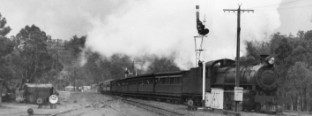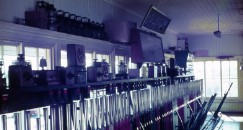Perth Box B (2)
WAGR - Eastern Railway (E. R.) | |
1938 WAGR MAP Mileage = 0 | |
Next Down Station: | Next Up Station: |
Quick Facts |
|
Opened |
Closed |
1921 |
1989 |
Mechanical |
Electrical |
120 Levers |
Illuminated Diagram |
Fate: Demolished |
|
The original Perth Box 'B' was situated on the suburban section of the 'Eastern Railway' and was opened prior to 1896. It was located at the east end of the Perth Goods Yard behind the Intermediate Road, and it had about 60 levers. When the carriage sheds were built in Perth, and country train operations transferred there from Fremantle in the 1920s, the new box (depicted) was built circa 1921 to control the extra tracks and signalling required. This was also in line with the transfer of the main loco depot to East Perth and the workshops to Midland Junction as the Fremantle site had become too restrictive.
The new Perth Box 'B' (seen here) was not a totally new contruction. Much of it had come from the old Kalgoorlie Box 'B', which had itself, been replaced by a new box built for standardisation. (The old Kalgoorlie Box 'B' was situated near the Maritana Street Bridge on the north side of this busy goldfields yard, and had about 69 levers. Its replacement being a box of 140 levers in two rows of 70 levers).
When rebuilt as Perth Box 'B', it was located some two hundred feet beyond the furthest extremity of Nos. 5 & 8 platforms between the down main line to No. 5 platform and the Intermediate road leading to the back platform of Perth Station. To the west - the Fremantle or 'Up' side - Perth Box 'B' originally worked with Perth Box 'A', which was located at Melbourne Road.
The Melbourne Road Box was replaced in 1958 by another Perth 'A' Cabin to make way for the Mitchell Freeway, and combined the operations of the West Perth and Melbourne Road cabins.
Towards the end of Perth Box 'B's life though, it was more usual to work with Cottesloe, although on the odd occasion Subiaco would 'cut-in' to deal with a shunt train. Perth Box 'B' could also find itself working directly with Claremont, North Fremantle or Fremantle Box 'B'. To the east, Perth Box 'B' worked with Perth Box 'C' located at the other end of the station, although before the 'Horseshoe Bridge' was built, there was a small cabin to control the level crossing there, it was aptly called the William Street Gate Box.
The interior view of Perth Box 'B' was quite plain, maybe brought about by it's length. The centre instrument shelf bracket, which supported only a short shelf for two auxilliary block bell plungers wobbled quite a bit when giving a long series of bell codes! The square box on the shelf nearest the camera was an intercom to Perth Box 'C', and was used for passing on information about Goods trains and other train movements. The shelf above the end window held a large number of Hand Lamps - one wonders where they all are now?
The illuminated track diagram of Perth Box 'B' was of the W.A.G.R. standard 'black' variety, but it was probably the longest at eleven feet in length! This made photographing it awkward, without resorting to 'sectionalising'. However, it was not always such a long diagram - as it was extended slightly when the cabin took over the functions of Perth 'A' Cabin (the successor of Melbourne Road). Luckily, the majority of the diagram has survived. The sharp-eyed will note the fact that whilst the external name board read Perth "Box B", the diagram carried the name City 'B' Cabin! Also, the brackets for the previous (non-illuminated) diagram and lamp can be seen on the ceiling. The last linen track diagram from this Box has also survived, although is in a very sad state of repair and urgently needs preservation and re-drawing.
The Signalman at this very busy cabin controlled the up and down main lines from West Perth on its way to the eastern end of the station. Just inside the very imposing bracketted Down Home signals, the Down main line branched off and ran behind the cabin to the back platform (No. 7 & 8), passenger and parcels yard. Immediately in front of the signal cabin, points diverged across to the No. 1 Platform (the 'Fremantle Dock') and No. 2 Platform, and a scissors crossover enabled goods trains to reach the down goods line through the station from the down main. This was also used by some passenger trains to reach No. 6 Platform via another set of scissors crossovers further up the station when No. 5 Platform was occupied. Across the main lines, opposite the signal cabin, were five sidings used as stow roads for railcar sets, these being all that remained of the old Perth goods yard, the rest now being occupied by the Wellington Street bus station and Entertainment Centre. The carriage sheds were behind the signal cabin, and this was where the former country passenger trains were stabled, serviced and cleaned. To the east of the passenger yard was the large parcels depot where luggage and parcels were loaded into vans for attaching to the country passenger trains.
For most of its life, the cabin was manned 24 hours a day, 7 days a week by four Special Class Signalmen working six hour shifts (one on each shift, 'Royal Show Week' excepted - when a second 'assistant' signalman was rostered on during certain hours) and two Block Boys who covered the hours between 5am to 9pm. Alteration to the 'Award' in 1978 meant that Special Class Signalmen were brought into line with their 1st, 2nd and 3rd Class counterparts in working an eight hour shift per day. Later, when the Fremantle line was closed to passenger traffic for a number of years, even the Block Boy was withdrawn, and the cabin's rating was further downgraded. When passenger services were returned to the Fremantle line, the cabin enjoyed a brief return to its former self, but never recaptured its true glory days. It did however, have the distinction of being the only signal cabin in the Perth station for a breif period. This was brought about by, and during the building of, the multi-story car park over the eastern end of the station, Perth Box 'B' operated the Perth Box 'C' end by means of a small, computerised push button panel which accompanied a new diagram. The new, enlargened, relay room provided for this purpose (and now used for signalling the electrified lines), can still be seen near the north side of the William Street (horseshoe) bridge, and is now the only link to the city's largest lever cabin.
Information researched and interpreted by Chris. J. E. French of SignallingWA
Additional information by SIGWA members Robert Pearce and Paul Hrebtiewsky
Any additional information on this signal cabin would be most welcome - please use the e-mail form provided on this page.
Photographs © by Lynton Englund, Fred Rance, Chris. J. E. French and Original Perth Box B - Pendon Museum UK via Rail HeritageWA Archives
Buy this page or View your SignallingWA Shopping Cart
This page is copyright, and permission must be sought from SignallingWA before this page is used for any purpose other than personal education.
PERTH BOX 'B' (2) Employees | ||
This list may not be complete and does not yet include employees who worked here without being appointed. Where an appointment date is unknown, the Weekly Notice (WN) date advising of the appointment or other official documentation, i.e. Certificate of Competency (CC) will be used. | ||
Name | Appointed | Position |
Chapple, Ivor R. | 24/10/1975 | Signalman, Class 1 |
Archer, Stanley L. | 15/11/1975 - W. N. 44 / 1975 | Signalman, Class 1 |
Morawiec, Ted | 24/10/1975 | Signalman, Class 1 |
Ross, Ken. H. D. | 03/02/1976 | Signalman, Class 1 |
Pearce, Robert L. | 24/06/1976 | Signalman, Class 1 |
Dewar, Phillip J. W. | 12/01/1977 - W. N. 02 / 1977 | Signalman, Class 1 |
Lyons, Bernie P. | 21/01/1977 | Signalman, Class 1 |
Watling, A. S. | 06/12/1978 | Signalman, Class 1 |
| Warne, Rex Lindsay | 25/09/1979 - CC | Signalman, Class 1 |
| French, Chris. J. E. | 30/06/1981 | Signalman, Class 2 |
| Bentley-Taylor, Gary | 23/02/1982 | Signalman |
Bentley-Taylor, Gary | 12/11/1983 | Signalman, Class 1 |
| Bailey, Phillip W. | 25/09/1985 - CC | Signalman, Class 1 |
| Rance, Fred | 24/02/1987 - CC | Signalman, Special Class |
Bailey, Phillip W. | 15/04/1987 - CC | Signalman, Special Class |
Rance, Fred | 01/12/1987 - CC (for Console) | Signalman, Special Class |
Bailey, Phillip W. | 07/01/1988 - CC (for Console) | Signalman, Special Class |
Is a name missing? Please submit any corrections / additions with suitable evidence using the e-mail form above. | ||
18/02/2013 - Former W. A. G. R. Employee Fred Rance remembers:
"In 1987 I learnt and passed my examination for the safeworking of BOX B CITY. During 1989 a small panel was made to take the place of BOX C CITY as it was to close. It was controlled by the use of different buttons, it also had a small screen that was used to display the commands done by the signalman whilst setting the roads and signals. This was displayed so you could read it to make sure that is the route you wanted the train to take. It was interlocked with BOX B the same as BOX C was and a former signalman from BOX C would work the panel while another signalman would work the BOX B frame. The technology used for this type of work was so successful it was also used at Claisebrook before the cabin there was closed down also. This form of signalling was also used up in Metro Control on their panel, but some modificatios were required to operate it properly. The people in the photo in BOX B are Mr. Kevin Reeves working the panel and Mr. Doug Hughes acting as 'Block Boy' (Train recorder), whilst Mr.Kevin Jarrett worked the frame."


